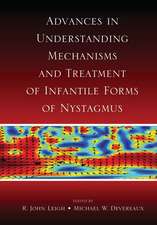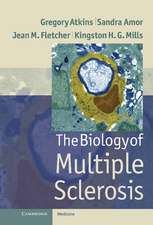Epilepsy: Models, Mechanisms and Concepts
Editat de Philip A. Schwartzkroinen Limba Engleză Paperback – 31 ian 2007
Preț: 812.31 lei
Preț vechi: 855.07 lei
-5% Nou
Puncte Express: 1218
Preț estimativ în valută:
155.45€ • 159.20$ • 129.31£
155.45€ • 159.20$ • 129.31£
Carte tipărită la comandă
Livrare economică 18 martie-01 aprilie
Preluare comenzi: 021 569.72.76
Specificații
ISBN-13: 9780521033503
ISBN-10: 0521033500
Pagini: 560
Ilustrații: 75 b/w illus. 11 tables
Dimensiuni: 152 x 228 x 32 mm
Greutate: 0.81 kg
Editura: Cambridge University Press
Colecția Cambridge University Press
Locul publicării:Cambridge, United Kingdom
ISBN-10: 0521033500
Pagini: 560
Ilustrații: 75 b/w illus. 11 tables
Dimensiuni: 152 x 228 x 32 mm
Greutate: 0.81 kg
Editura: Cambridge University Press
Colecția Cambridge University Press
Locul publicării:Cambridge, United Kingdom
Cuprins
List of contributors; General introduction Philip A. Schwartzkroin; Part I. Chronic Models in Intact Animals - Concepts and Questions: Introduction; 1. The kindling model of epilepsy James O. McNamara, Douglas W. Bonhaus and Cheolsu Shin; 2. Focal trigger zones and pathways of propagation in seizure generation Karen Gale; 3. Genetic models of the epilepsies Phillip C. Jobe, Pravin K. Mishra, Nandor Ludvig and John W. Dailey; 4. Noradrenergic modulation of excitability: transplantation approaches to epilepsy research Olle Lindvall; 5. Sensitivity of the immature central nervous system to epileptogenic stimuli Solomon L. Moshé, Patric K. Stanton and Ellen F. Sperber; Part II. Features of the Epileptogenic Brain: Introduction; 6. Neurophysiological studies of alterations in seizure susceptibility during brain development John. W. Swann, Karen L. Smith, Robert J. Brady and Martha G. Pierson; 7. Electrophysiology and pharmacology of human neocortex and hippocampus in vitro Massimo Avoli; 8. Cell death, plasticity and epilepsy: insights provided by experimental models of hippocampal sclerosis JoAnn E. Franck; 9. Sprouting as an underlying cause of hyperexcitability in experimental models and in the human epileptic temporal lobe Thomas P. Sutula; 10. Rapidly recurring seizures and status epilepticus: ictal density as a factor in epileptogenesis Eric W. Lothman, Janet L. Stringer and Edward H. Bertram; Part III. 'Normal' Brain Mechanisms That Support Epileptiform Activities: Introduction; 11. Brain slice models for the study of seizures and interictal spikes Wilkie A. Wilson and Andrew Bragdon; 12. Generation of epileptiform discharge by local circuits of neocortex Barry W. Connors and Yael Amitai; 13. Study of GABAergic inhibition and GABAA receptors in experimental epilepsy Robert K. S. Wong and Richard Miles; 14. High potassium-induced synchronous bursts and electrographic seizures Christopher J. McBain, Stephen F. Traynelis and Raymond Dingledine; 15. Anti-epileptic effects of organic calcium channel blockers in animal experiments Erwin-Josef Speckmann and Jörg Walden; Recent advances; Index.
Recenzii
"...covers a broad spectrum of important issues and concepts and should stimulate discussion among clinical epidemiologists and basic scientists interested in the pathophysiology of epilepsy...a lucid, well thought out review of many of the major issues in epilepsy research and much of the progress that has been made over the past few decades. I highly recommend this volume." J.H. Schneiderman, The Canadian Journal of Neurological Sciences
"...well written and edited...would provide a more advanced reader an excellent overview of where research on basic mechanisms of the epilepsies now stands, and where it is heading." Robert S. Fisher, Electroencephalography & Clinical Neurophysiology
"...this is a book oriented to neuroscientists, neurologists, and neurosurgeons interested in epilepsy, that can clarify many concepts. These concepts are useful tools to understand antiepileptic drug mechanisms, the different age-related sensitivity of the brain to different insults, and the physiological mechanisms of normal brain that support an epileptic activity." Xabier Beristain, Neurological Research
"This book is an excellent reference for recent work in epilepsy research, in both thought-provoking and technical ways. It is highly recommended for scientists and clinicians interested in epilepsy." Cynthia L. Harden, Quarterly Review of Biology
"...well written and edited...would provide a more advanced reader an excellent overview of where research on basic mechanisms of the epilepsies now stands, and where it is heading." Robert S. Fisher, Electroencephalography & Clinical Neurophysiology
"...this is a book oriented to neuroscientists, neurologists, and neurosurgeons interested in epilepsy, that can clarify many concepts. These concepts are useful tools to understand antiepileptic drug mechanisms, the different age-related sensitivity of the brain to different insults, and the physiological mechanisms of normal brain that support an epileptic activity." Xabier Beristain, Neurological Research
"This book is an excellent reference for recent work in epilepsy research, in both thought-provoking and technical ways. It is highly recommended for scientists and clinicians interested in epilepsy." Cynthia L. Harden, Quarterly Review of Biology
Descriere
This book considers a number of major concepts and models in epilepsy research, to advance understanding of the basic mechanisms involved.












